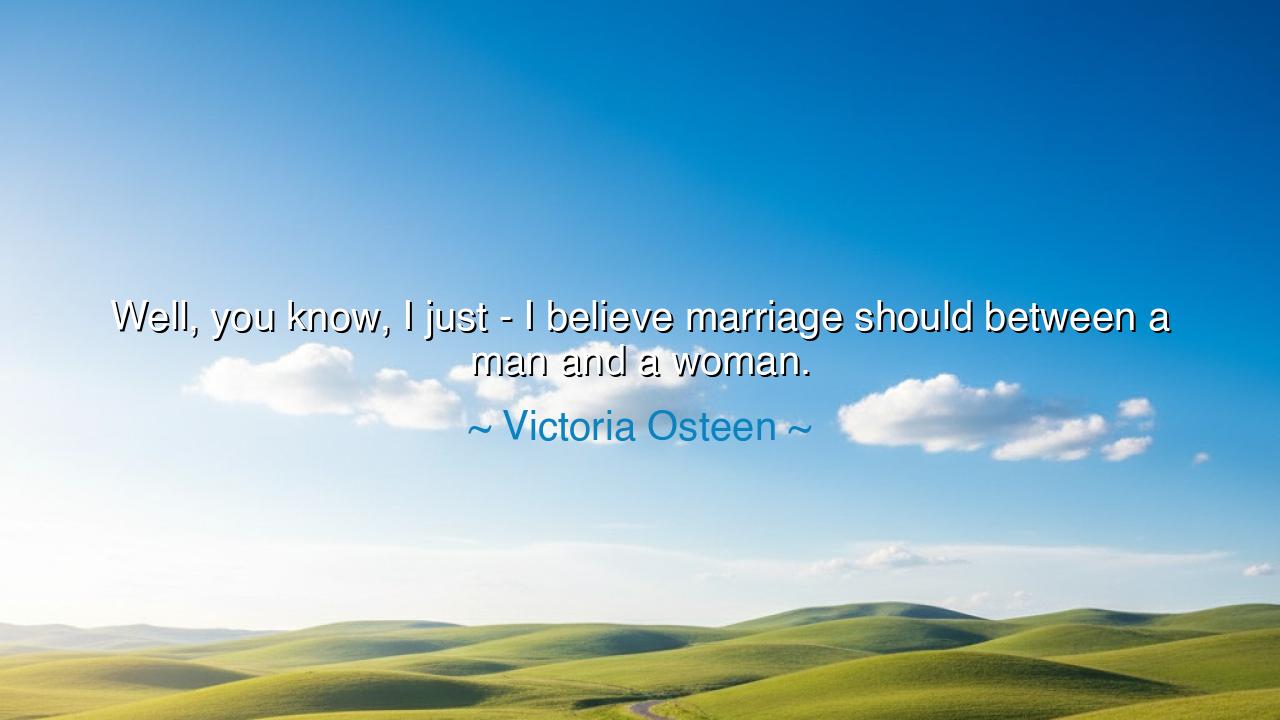
Well, you know, I just - I believe marriage should between a man






When Victoria Osteen declared, “Well, you know, I just—I believe marriage should be between a man and a woman,” she spoke not with the cadence of philosophy, but with the certainty of conviction shaped by tradition and faith. Her words are simple, yet they echo through centuries of human custom, carrying with them the weight of culture, religion, and heritage. For much of recorded history, marriage was indeed understood as the union of man and woman, a bond sanctified for the purpose of love, family, and the continuation of lineage. To her, to state this belief was not to innovate, but to reaffirm what had been held as sacred by generations before.
The meaning of this quote lies in the tension between tradition and change. By affirming marriage as a union between man and woman, Osteen anchors herself in a vision of the institution that prioritizes complementarity and the roles historically assigned to gender. For those who share her conviction, this belief is tied to divine order, to scripture, and to the structure of family as ordained by heaven. Yet for others, these words also represent a boundary, a limit placed upon the evolving definitions of love and union. Thus, the statement reflects not only a personal belief, but a crossroads where faith, culture, and social transformation meet.
The origin of such thinking reaches far beyond Osteen herself. Across civilizations—whether in the Roman Empire, the kingdoms of Israel, or the courts of medieval Christendom—marriage was constructed primarily around the union of man and woman. Laws and customs defined it as the cornerstone of society, binding not only individuals but entire families and communities. This vision endured for millennia, woven into the sacred texts of religions and the codes of nations. Osteen’s words are an echo of this long inheritance, voiced in an era where the institution itself was being reexamined and challenged.
History gives us examples of this very conflict. In ancient Greece, while love and companionship were celebrated in many forms, marriage remained the official and legal bond between man and woman, designed to produce heirs and preserve estates. Centuries later, in modern times, nations across the globe would begin to question and redefine this structure, allowing unions once forbidden. In the United States, the debate over same-sex marriage raged in the late 20th and early 21st centuries, with religious leaders and figures like Osteen standing firmly upon tradition, even as courts and legislatures began to expand the meaning of marriage to embrace new forms of love.
The wisdom—or perhaps the limitation—of Osteen’s words is that they hold fast to what has been known, but risk closing the door to what is yet to come. Tradition offers stability, yet if tradition becomes rigid, it can also stifle the growth of justice and compassion. The statement calls us to reflect: what is the true purpose of marriage? Is it solely the bond of male and female, as it was long defined? Or is it the covenant of love, fidelity, and shared life, regardless of form? Such questions burn at the heart of every society that wrestles with the balance between the eternal and the changing.
The lesson to draw is not simply to accept or reject Osteen’s words, but to recognize the power of belief in shaping human destiny. Each person must wrestle with the tension between heritage and progress, between conviction and compassion. To honor tradition is noble, but to deny the humanity of those who seek love outside its boundaries is perilous. The call of wisdom is to listen deeply, to weigh carefully, and to act not only with conviction but also with mercy.
What then must the listener do? If you hold to tradition, do so with humility, not with scorn for those who differ. If you embrace change, do so with patience, not with hatred for those rooted in the past. For societies endure not through shouting, but through dialogue, through the slow weaving together of hearts that disagree yet seek peace. Marriage, whether between man and woman or beyond, must be understood not only as a legal or religious construct, but as a place where love becomes covenant, and covenant becomes the foundation of life.
Remember always: belief shapes institutions, and institutions shape lives. Osteen’s words remind us that marriage has long been guarded by tradition, but history reminds us that no institution remains untouched by time. As the ancients taught, truth must be pursued with courage, but always tempered with compassion. In the end, what matters most is not only the form marriage takes, but the love, honor, and fidelity that breathe life into it.






AAdministratorAdministrator
Welcome, honored guests. Please leave a comment, we will respond soon